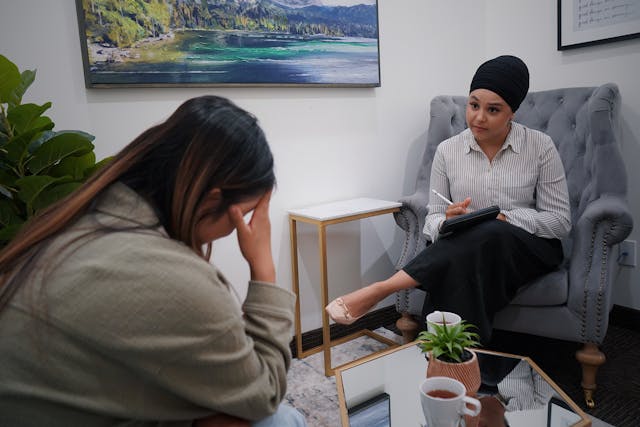Challenges in the first session
Engaging with a client, especially during the first therapy session, is crucial yet challenging. Mental health professionals understand that the initial therapy or counseling session, beginning from the client's experience in the waiting room, often sets the tone for subsequent sessions and can make all the difference in the therapeutic process.
One common challenge when starting therapy is client anxiety. Many new clients feel nervous or apprehensive about starting counseling or therapy. They may worry about being judged or fear discussing difficult topics. Another challenge is managing expectations. Clients often come into a consultation session with preconceived notions about therapy. Some might expect immediate solutions or miraculous changes after one session. Some might feel overwhelmed thinking about how many sessions it might take for them to experience change.
Sometimes, clients may present with crisis situations or severe symptoms that require immediate attention or focused diagnostic evaluation. In these cases, the planned structure for the first session may need to be adjusted.
Healthcare providers, along with those in private practice, know the importance of creating a supportive environment where clients feel comfortable sharing their experiences. Engaging with new clients is a skill many therapists develop over time through good practice as they learn to adapt to different personalities and communication styles.
10 tips to help you start a counseling session with your client
Starting a counseling session on the right note is crucial for building a strong therapeutic relationship with your client that can help in future therapy sessions. Here are some practical tips to help you create a positive and supportive atmosphere, setting the stage for effective communication and trust-building from the very beginning:
1. Establish a welcoming environment
Create a comfortable and inviting space for your new client. Ensure that the counseling room is tidy, well-lit, and free from distractions. Offer them a seat and reassure them of confidentiality to help ease any initial tension.
2. Greet your client warmly
Begin the session with a friendly and genuine greeting. A warm smile and a handshake (if appropriate and culturally sensitive) can help establish a connection and set a positive tone for the session.
3. Engage in small talk
Initiate some light conversation to break the ice and build rapport. Small talk can help you and your client feel more at ease before getting into more substantial topics. Ask about their day or any recent events to show genuine interest in them as a person. You can also use this to establish a common ground.
4. Active listening
Practice active listening from the moment your client starts speaking. Show empathy, understanding, and validation by maintaining eye contact, nodding, and providing verbal affirmations such as "I see" or "I understand."
5. Encourage openness
Create a non-judgmental atmosphere where your client can openly express their thoughts, feelings, and concerns. Use open-ended questions to encourage them to elaborate on their experiences and explore their emotions more deeply. Approach the client's experiences with curiosity. Hold space for conversations about their social and family history and other relevant information.
6. Clarify goals and expectations
Take the time to discuss the purpose of the counseling session and what your client hopes to achieve from therapy. Clarify any misconceptions and answer the client's questions about the counseling process and outline what they can expect regarding confidentiality, session frequency, appropriate time off, and possible follow-up appointments.
7. Collaborative approach
Emphasize that counseling is a collaborative process where you and your client work together to address their needs and achieve their goals. Encourage their active participation in setting the agenda for the session and developing a treatment plan that feels comfortable and manageable for them.
8. Provide reassurance
Reassure your client that seeking help is a positive step towards personal growth and healing. Let them know that you are there to support them through their journey and that it's okay to experience a range of emotions during therapy.
9. Normalize feelings of discomfort
Acknowledge that it's normal for clients to feel nervous or apprehensive during their first counseling session. You can do this by letting them take a few more minutes to think or settle down. Normalize their feelings of discomfort and reassure them that it's okay to take things at their own pace.
10. End on a positive note
Conclude the session by summarizing key points discussed, highlighting insights gained, and asking if they have follow-up questions. Provide clear instructions for scheduling future sessions.
How to establish and maintain a good connection with your client
Establishing and maintaining a good connection with your client is essential for effective counseling. A strong rapport enhances communication, trust, and therapeutic outcomes. Here are some tips to help you cultivate a deep and meaningful connection with your client:
Cultivate empathy and understanding
Strive to understand your client's perspective, emotions, and experiences without judgment. Empathize with their struggles and validate their feelings. Show genuine care and concern for their well-being to foster a strong connection based on trust and mutual respect.
Active listening and validation
Practice active listening by giving your full attention to your client's thoughts when they speak. Reflect on their thoughts and emotions to demonstrate that you understand and validate their experiences. Avoid interrupting or imposing your interpretations, making them feel heard and valued.
Build rapport and trust
Invest time in building rapport with your client by showing warmth, authenticity, and sincerity. Use appropriate humor, share relevant personal experiences (when appropriate and beneficial), and engage in genuine conversation to create a comfortable and welcoming atmosphere. You can also assure them that you are open to adjustments and ask them to provide feedback during sessions. Trust is foundational in therapy, so prioritize transparency and consistency in your interactions.
Flexibility and adaptability
Recognize that every client's issue is unique, and their needs may evolve. Remain flexible and adaptable, adjusting your therapeutic strategies and interventions to align with their changing circumstances and preferences. Be willing to meet them where they are and tailor your interventions accordingly.
What to do next after conducting a successful session with a client
After conducting a successful session with a client, there are several essential steps to take to support the system and ensure continuity of care and ongoing progress:
- Session documentation: Promptly document critical points discussed, therapeutic interventions used, progress made, and any significant insights gained during the session in the client's file or electronic record. Accurate and thorough documentation is essential for continuity of care, treatment planning, and monitoring progress over time.
- Treatment planning: Update the client's treatment plans based on the progress made and any new insights gained during the session. Adjust the therapeutic plan to reflect the client's evolving needs and goals.
- Self-care: Take time to engage in self-care activities to recharge after the session. Reflect on your emotional reactions and experiences during the session. Prioritizing your well-being lets you show up fully present and attuned to your clients in future sessions.
- Consultation or supervision: If you encounter complex cases or challenging clinical situations during the session, seek consultation or supervision from a colleague, supervisor, or mentor. Collaborating with peers and receiving feedback from experienced professionals can provide valuable insights and support your professional development and therapeutic approach as a therapist.
Final thoughts
Initial interactions set the foundation for the entire therapeutic journey. When we create a welcoming environment, practice active listening, and address the client's specific needs, we can establish trust and rapport from the very beginning. It's important to remember that the initial plan may evolve over several sessions as the therapist gains a deeper understanding of the client's experiences and main concern. Flexibility and adaptability are key qualities that allow therapists to adjust their approach and treatment goals as needed.
Ultimately, the goal of therapy is to support clients in their personal growth and healing. As therapists guide clients through this process, it's essential to encourage self-compassion and remind clients that seeking help is a courageous step. Remember that each session is an opportunity to deepen understanding, build trust, and work collaboratively towards positive change in the client's life.




.jpg)

.jpg)

.jpg)

.jpg)


.jpg)





.jpg)
.jpg)
.jpg)
.jpg)
.jpg)
.jpg)
.jpg)
.jpg)